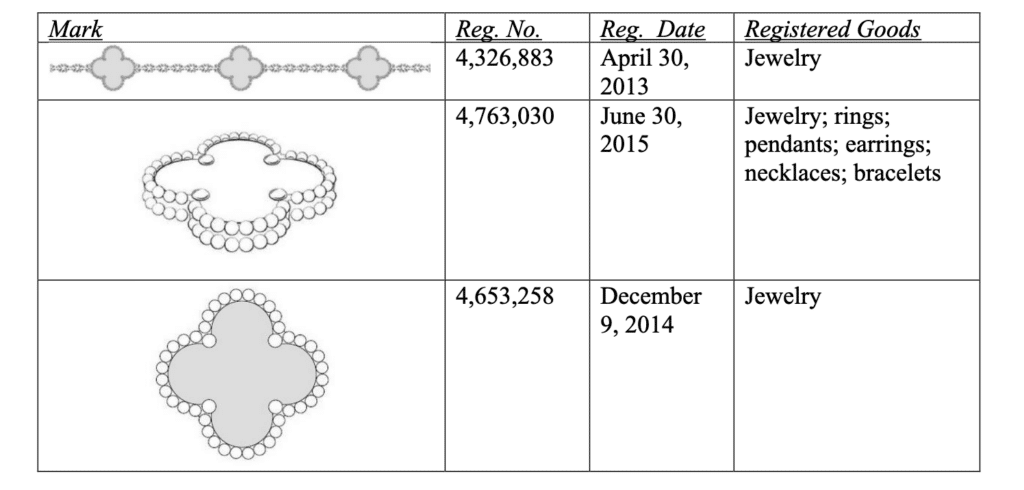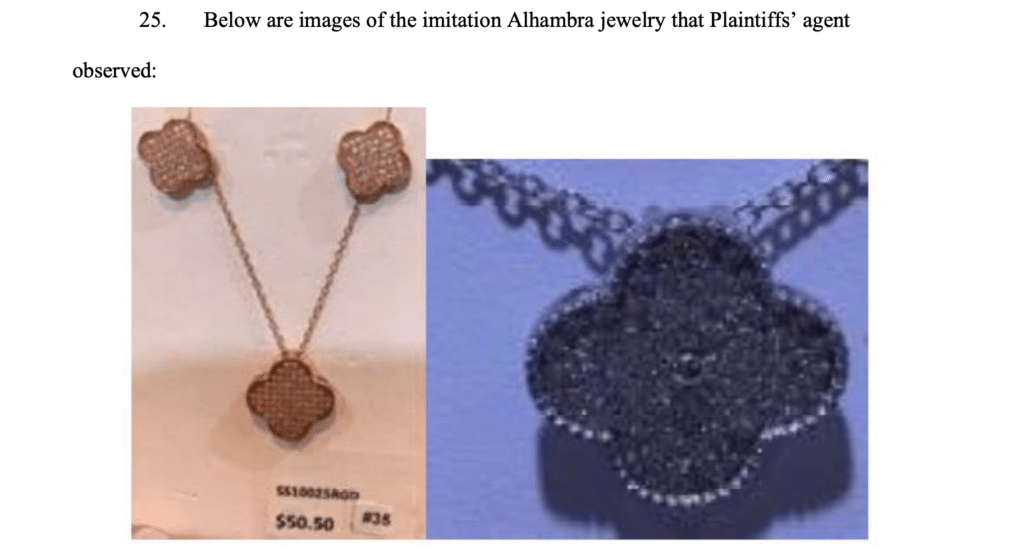Richemont is taking legal action against Silversmiths Inc. in a bid to get a handle on the rising volume of goods looking to piggyback on the appeal of its Van Cleef & Arpels brand. In the complaint that it filed in a federal court in New Jersey on February 12, the Swiss luxury goods conglomerate claims that the New Jersey-based company is on the hook for trademark counterfeiting, infringement, and dilution for producing and selling necklaces that closely mimic the distinctive quatrefoil-shaped design of Van Cleef & Arpels’ Alhambra collection, which was first introduced in the late 1960s and remains one of the brand’s best-known offerings.
In the newly-filed complaint, Richemont maintains that Silversmiths’ products infringe Van Cleef & Arpels’ “instantly recognizable” Alhambra trade dress, which consists of “a three-dimensional configuration of a quartrefoil-shaped jewelry ornament in which … “the top portion of the quatrefoil piece has an outer edge that is beaded with an inner portion that is flat as well as four larger beads positioned at central points within it; the bottom portion of the quatrefoil piece also has an outer edge that is beaded; and the center portion of the quatrefoil piece is solid and not empty.”

Delving further into its rights in the Alhambra design, for which it maintains trademark registrations in the U.S., Richemont contends that Van Cleef has “made widespread and exclusive use of the iconic Alhambra trade dress” for decades, and has “invested a considerable amount of time, effort, and money advertising and promoting their jewelry and watch products bearing the trade dress and has enjoyed enormous success selling such products in the U.S. and around the world.”
Against that background, Richemont alleges that Silversmiths is offering up its counterfeit versions of the Alhambra jewelry via its website and at trade shows throughout the country, including in New York City, Miami, Florida, and Las Vegas, Nevada, Richemont argues, asserting that the defendant “advertise[s] its jewelry as being made of ‘sterling silver,’ ‘gold,’ and other fine materials, and necklaces on [its] website range in price from $40 to $700.”
Richemont asserts that its representatives first identified that Silversmiths was selling imitation Alhambra jewelry in early 2020 and sent a cease-and-desist letter to the company. However, Silversmiths allegedly ignored the warning and continued to market and sell the counterfeit jewelry. In December 2023, Richemont sent another cease-and-desist letter, which again went unanswered. The lawsuit states that in April 2024, Richemont made a final attempt to halt the alleged infringement, yet Silversmiths persisted in its unauthorized sales.

Richemont claims that Silversmiths’ use of beaded quatrefoil motifs with similar metalwork and nearly identical silhouettes creates a likelihood of consumer confusion and falsely suggests an affiliation between the two companies. Moreover, the Johann Rupert-led group maintains that Silversmiths is knowingly engaging in trademark counterfeiting and unfair competition, stating that the defendant is operating in an “intentionally fraudulent, malicious, willful, and wanton” manner in its continued sale of unauthorized jewelry.
Still yet, Richemont asserts that Silversmiths is profiting from the reputation and goodwill associated with the Alhambra collection while depriving Richemont of control over its brand image.
With the foregoing in mind, Richemont is seeking a permanent injunction to prevent Silversmiths from selling the allegedly infringing products, along with monetary damages, including disgorgement of profits derived from the sales. It is also seeking statutory damages of up to $2 million per counterfeit mark per type of goods sold and the destruction of all infringing jewelry.
The Bigger Picture
As Van Cleef & Arpels’ authentic offerings surge in popularity (or as Highsnobiety put it not too long ago, “Van Cleef & Arpels Alhambra motif has blown up in popularity, becoming [2024’s] jewelry grail for those eager to flex”), the market for copycat – and counterfeit – goods is becoming increasingly robust. One need not look further than the results of a brief Google search for “gold flower bracelets” to see an array of offerings that mimic Van Cleef’s Alhambra designs – from $39 gold plated bracelets to diamond and gold varieties with price tags of $2,000-plus. At the same time, the jewelry collections being offered up in high-end department stores are also telling, as there is no shortage of Van Cleef-esque wares in the mix.
While Richemont and Van Cleef & Arpels have not been terribly aggressive in terms of enforcement in the U.S. despite maintaining trademark rights in – and at least five registrations that cover – the Alhambra design, the suit at hand may be an indication of a bigger increase in litigation aimed at cracking down on the market for fakes.
Arlene Marce, Head Counsel for IP at Van Cleef & Arpels, stated in connection with the case, “This is not the beginning of our fight – it’s the relentless escalation of our commitment to defending authenticity, quality, and clients’ trust. Counterfeiting harms luxury brands and misleads consumers. We will not stand for it.”
The case is Richemont International SA v. Silversmiths, Inc., 2:25-cv-01204 (D. NJ).














